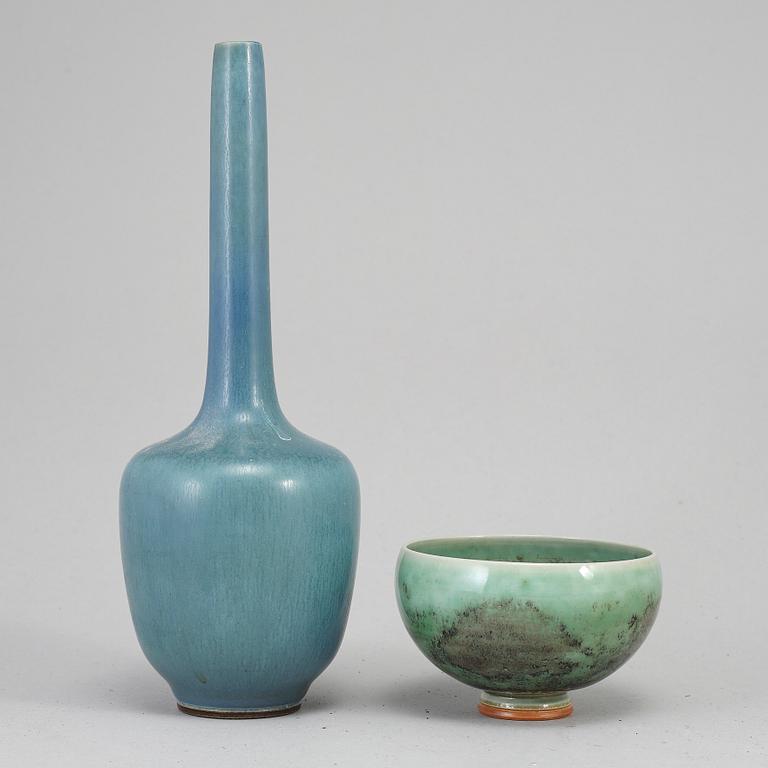Berndt Friberg
BERNDT FRIBERG, a stoneware vase and bowl, Gustavsberg studio, Sweden.
Signed Friberg with the studio mark and year letters. Height 5-21 cm.
Wear, the vase with repair to rim.
Provenance
The Collection of Wivica Ankarcrona Borell.
Bukowskis has been entrusted to sell part of the vast collections of Art and Antiques after Wivica Akarcrona Borell (1935-2019).
The foundation of the collection was laid by Rear Admiral/Flag officer Sten Ankarcrona (1861-1936). Ankarcrona first got a taste for the Asian Art while following his fathers’s footsteps serving as ‘enseigne de vaisseau’ for the French navy “la Royale” during the years 1885-1889, when his Fregatt sailed in the area. Ankarcrona continued to ad on to the collection, later in life when he was sent on a special mission to Japan in 1923. He brought back vast collections of lacquer, bronzes, textiles, ceramics.
In 1911 the family moved to the mansion like duplex next to Sturegatan in Stockholm. The elegant home and their summer house at Brevik by Erstaviken where Ankarcrona created a Japanese garden (1923-27) and even set up a complete Japanese building was documented in the the magazine 'Svenska Hem i ord och bild' in 1928, which provide us with a fascinating window into this golden age of European collecting. The world renowned collection received many prestigious visitors throughout the years, the guest book contains signature of both the Swedish king Gustav VI Adolf as well as the Japanese crown prince, later Emperor Akihito.
Stens son Sten S:son Ankarcrona (1904-1981, continued the tradition of collecting, amongst other things Swedish 18th Century furniture and art, pieces that worked well with family heirlooms from the Bergenstråhle, Bohnstedt, Cassel, Mörner and Lybecker families.
Wivica was married to Ulf Borell, appointed physician to the Swedish royal family. She was a loyal visitor to the auctions and museums around the world. Her friends and family also know her as an opera habitué who never missed a new set. Her apartment was located at the top floor of the house by Sturegatan, in the elegant apartment new additions and finds from the auction scene mixed with old family heirlooms, many that can be seen in the magazine article of 1928.
Designer
Berndt Friberg was a Swedish ceramicist and master potter. He began working with ceramics at a very young age. Eventually, he trained in Denmark before returning to Sweden and Raus Stenkärlsfabrik. After a time at Svedala Slipvarufabrik in the 1920s, Berndt Friberg was employed at Gustavsberg porcelain factory in 1934. He was primarily hired to threw the objects designed by the artistic director Wilhelm Kåge. From 1937, Friberg also worked with Stig Lindberg. Friberg made his debut as an independent ceramicist in 1941 when he exhibited at the Gustavsberg shop on Birger Jarlsgatan in Stockholm alongside Calle Blomqvist and Stig Lindberg.
Many more exhibitions followed over the years. His first solo exhibition was presented at Nordiska Kompaniet in Stockholm in 1954 and it became a public success. Friberg's talent lay in both designing objects and then being able to throw and glaze them. The result was pieces in various sizes, from small miniatures, with the smallest no taller than a couple of centimetres, to large floor vases. The forms were classical, inspired by Chinese stoneware from the Song dynasty (960-1279). He constantly refined the forms and became a master of glazes. The early glazes were matte, known as hare's fur glazes, and later, towards the 1960s, came the glossy glazes such as "oxblood" and "aniara."
During 1957-58, Friberg began working with various patterns in the glaze. The most sought-after pieces by Friberg are large vases in attractive shapes with the matte hare's fur glazes.
Read more








































